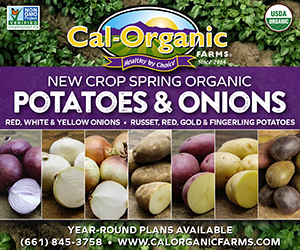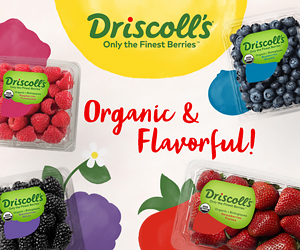Michael Ableman has been farming organically for more than four decades and is a major voice in the organic farming movement. He is the founding director of the Center for Urban Agriculture at Fairview Gardens, an organic farm and educational institute in Goleta, CA. He currently lives and works on his 120-acre family farm on Salt Spring Island in British Columbia, and he also directs Sole Food Street Farms, a large urban farming initiative in downtown Vancouver that employs people dealing with addiction, mental health issues, and poverty. He joined OPN for a conversation about his work.

Michael Ableman, Founding Director, Center for Urban Agriculture at Fairview Gardens and Sole Food Street Farms
Can you give us a brief background of how you got your start as an organic farmer?
I started at the age of 18 when I joined the Sunburst community in California. I turned 65 years old this year, so that was 47 years ago. At the time, Sunburst Farms was the largest producer and distributor of organic food in the U.S. We had three different parcels of land totaling 4,000 acres on which we produced a huge range of products, which supplied our own distribution company and four Sunburst Farms natural food stores. At 18 years old, I was managing the community’s 100-acre organic pear and apple orchard in the Cuyama Valley.
It was an incredible opportunity, exposing me to a wide range of agricultural experience. My fire and passion for this work really started during those years. I eventually left the community, did some agricultural work in British Columbia, and then returned to California to take over the development and management of Fairview Gardens, a 12-acre farm in Goleta, which I ran for close to 20 years.

Fairview Gardens in Goleta, CA
Tell us about your time at Fairview and the establishment of the Center for Urban Agriculture.
During my tenure, we were growing 100 different fruits and vegetables, employing up to 30 people. We ran cooking classes with well-known chefs, farming workshops, and numerous programs for local schools. The farm was extremely productive, using systems that at the time seemed innovative—row crops growing in the alleys of the orchards, insane crop diversity, huge compost piles recycling the organic waste from the surrounding community, chickens and goats, concerts, tours, and community events.
The land we were on was zoned for 52 condominiums, and I was able to convince the owners to give me some time to try to raise the money to protect it and to preserve it. They gave me a year to raise a million bucks, which in today’s dollars is roughly $8 million. We formed the Center for Urban Agriculture (a 501(c)(3) nonprofit), raised that money in eight months, and created what was at the time one of the first active agricultural conservation easements, one that not only dictated how that land had to be farmed and stewarded but also required that the land be used for education. That document gave that land a voice and protected it in perpetuity. It was a miracle that we actually pulled it off; many people thought it was not possible.

Michael Ableman, Co-Founder, Sole Food Street Farms
What led you to eventually leave Fairview?
As time went on, I was feeling more like a manager than a farmer, and I wanted to get back to the work of farming. I also had a dream of owning land, which had become impossible in the state of California—we just could not afford to do it. So we moved 1,400 miles north to Salt Spring Island off the coast of British Columbia and eventually ended up on this incredible 120-acre farm, which is as different from Fairview Gardens as you can possibly get. This land is surrounded by wildness and protected forest and a pristine lake, unlike Fairview Gardens which was surrounded by tract home developments and shopping centers.
So we’ve developed a pretty amazing project here—our family farm, where we produce vegetables, fruit, grain, dry beans, and some livestock. But after a while, I wanted to get back into the trenches and use my skills to support folks who are underserved. So about 13 years ago, I co-founded a project in the city of Vancouver in the neighborhood where the phrase “skid row” was coined (it's a logging term). We called the project Sole Food Street Farms, and we employ about 25-30 people, all of whom are dealing with long-term addiction, mental illness, and material poverty. Our mandate is very simple—first to provide a sense of purpose and belonging to folks who are dealing with stuff many of us could never endure, and to create a credible model of urban production agriculture.

Sole Food Street Farms provides employment and a sense of purpose and belonging, while creating a model of urban production agriculture
Tell us more about your work at Sole Food and its impact on the people you work with.
We produce an average of 25 tons of food (mostly greens) annually on approximately 4 acres of pavement, provide agricultural training and employment to folks who are considered “hard to employ,” and offer other support such as a breakfast program, workshops in financial literacy, cooking, canning, and drivers ed, etc. We take people to the hospital when needed and pick them up from jail.
When we started that project, I had numerous preconceptions and very low expectations. I came to this work with my own prejudices about people who are dealing with long-term addiction, but I have learned so much from the people we work with. I’ve seen remarkable changes—things I never would’ve expected. Not only have many of our staff become accomplished farmers, some have gotten off of social assistance, and folks who had not held a job for five months are still working with us after 13 years. That’s pretty amazing.
There have been a couple studies on the project that concluded that for every $1 we pay our staff, there is a $4.25 savings to the healthcare, legal, and social service systems and to the environment. My fourth book, Street Farm: Growing Food, Jobs, and Hope on the Urban Frontier, tells the social and spiritual story of the project, and there is a new book coming out this spring titled Farm The City: A Toolkit for Setting Up a Successful Urban Farm, which provides the nuts and bolts of how we physically implemented the project and provides an introductory “toolkit” on production market farming in the city.

Salt Spring Island produce
Would you be willing to give us a bit of a preview of that? What are some of the technical considerations when farming in the downtown area of a major city?
One of the biggest challenges of producing significant quantities of food in the city is that most native urban soils are too contaminated to grow in, or they’re paved. In addition, most urban landowners or developers do not want to tie up urban land that is slated for development. They want assurances that you are prepared to move on short notice. So we created a system that addresses both of those issues by designing a box that isolates the growing medium from contaminated soil or pavement and is easily moveable.
We are growing in some 8,000-10,000 of those boxes. They’re moveable, stackable, nestable, have interconnected drainage, and are indestructible. The problem, though, is that when you put living soil in a box and separate it from the broader ecology of an open field, all kinds of things happen that are not supportive of biological life. So the learning curve was huge.
If you put living soil into a container, and if you’re not really paying attention, the organic matter content dissipates quickly. Using this system requires that we are rigorous in frequent applications of worm castings, high-quality compost, and compost teas in order to maintain the biology and soil life in those boxes.

Michael Ableman shares that "good food is the birthright for everyone"
As a veteran organic farmer, what advice would you give other organic farmers?
I’m cautious about offering advice because every individual, every community, and every situation is so different. But there are basic principles that are universal. In the back of my book Street Farm, I offer what I called my Manifesto and a list of basic growing and marketing principles, which I have learned in the last 47 years of doing this work.
For most of those years, the bulk of the high-quality organic food I was growing only went to a very narrow segment of the society—those who could afford it. But good food is the birthright for everyone, which is one of the reasons I started the Sole Food project.
So those of us who have developed the skills and the knowledge to do this work well and have stabilized our farm businesses have a responsibility to share our knowledge and to find creative ways to make sure that everyone has a place at the table. I know we are all struggling with numerous challenges to maintain viable farming enterprises, but I also know that we have a huge role to play in feeding those who are underserved, in educating our communities, and in environmental restoration and protection—especially considering our unique ability to use our land to sequester carbon and water.






